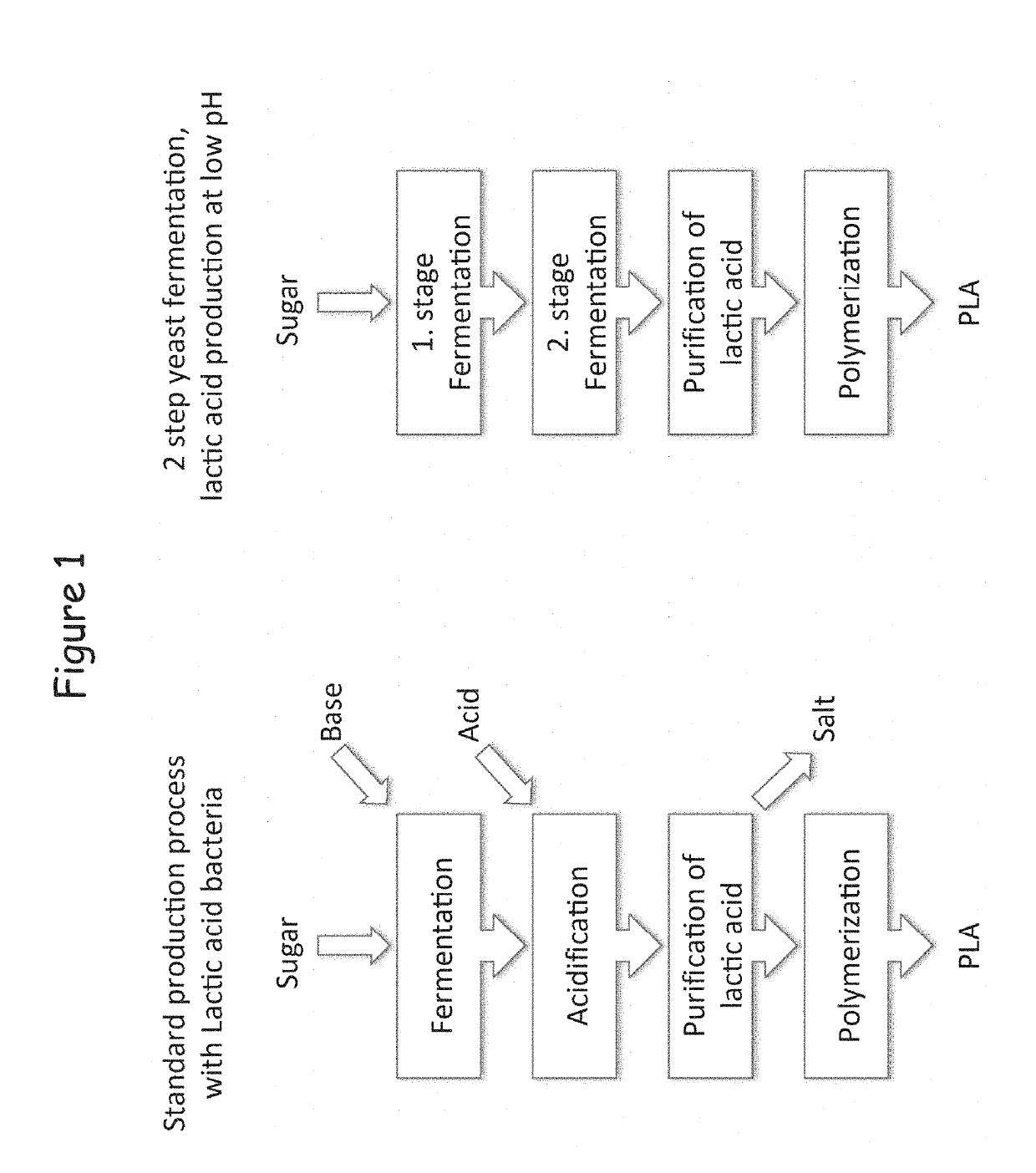Method for producing lactic acid
a lactic acid and lactic acid technology, applied in the field of lactic acid production methods, can solve the problems of limited viability of strains and limits overall productivity, and achieve the effects of avoiding the inhibitory effect of lactic acid, high cell density, and maximum lactic acid yield
- Summary
- Abstract
- Description
- Claims
- Application Information
AI Technical Summary
Benefits of technology
Problems solved by technology
Method used
Image
Examples
example 10
rocess for Lactic Acid Production Under Controlled Conditions
[0266]The production process of lactic acid is followed in a two-step process: first step is the cultivation of yeast cells to high cell densities in a fed-batch process and the second step is a batch process for lactic acid production with high initial inoculum. As shown previously (Example 1) in shake flasks experiments at low pH of 3.0, the fermentation rate and ethanol yield was significantly improved with high initial inoculum in a medium containing lactic acid and high glucose concentration. This suggested that inoculum size plays a significant role in determining the performance of a fermentation.
[0267]The first step starts with a batch culture in a medium containing 1.8 g / l of YNB, 5 g / l of (NH4)2SO4 and 20 g / l of glucose. The dissolved oxygen concentration is maintained at 20% by controlling the stirrer speed and aeration rate. The temperature and pH are maintained at optimal values at 30° C. and 5.0, respectively...
example 11
e Two-Step Process for Lactic Acid Production
[0269]The production process of lactic acid is followed in a two-step process: first step is the cultivation of yeast cells to high cell densities in a fed-batch process and the second step is a batch process for lactic acid production with high initial inoculum.
[0270]First Step of Lactic Acid Production:
[0271]The medium for the first culture step is prepared according the following tables, glucose is added to a concentration of 25 g / L:
[0272]Minimal Medium Salts
(NH4)2SO45.0 g / LKH2PO43.0 g / LMgSO4•7H2O0.5 g / L1000× vitamin solution1 mL / L100× trace elements10 mL / L
[0273]The ingredients are dissolved in H2O, the vitamin solution and the trace elements are added, the pH is adjusted to 5.0 with hydrochloric acid. The medium is sterile filtered.
[0274]1000× Vitamin Solution for Minimal Glucose Medium
D-biotin0.05 g / LCa-D-pantothenate1.00 g / LNicotonic acid1.00 g / LMyo-inositol25.00 g / L Thiamine hydrochloride1.00 g / LPyridoxal hydrochloride1.00 g / Lp-ami...
PUM
| Property | Measurement | Unit |
|---|---|---|
| pH | aaaaa | aaaaa |
| OD | aaaaa | aaaaa |
| temperature | aaaaa | aaaaa |
Abstract
Description
Claims
Application Information
 Login to View More
Login to View More - R&D
- Intellectual Property
- Life Sciences
- Materials
- Tech Scout
- Unparalleled Data Quality
- Higher Quality Content
- 60% Fewer Hallucinations
Browse by: Latest US Patents, China's latest patents, Technical Efficacy Thesaurus, Application Domain, Technology Topic, Popular Technical Reports.
© 2025 PatSnap. All rights reserved.Legal|Privacy policy|Modern Slavery Act Transparency Statement|Sitemap|About US| Contact US: help@patsnap.com


